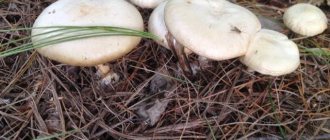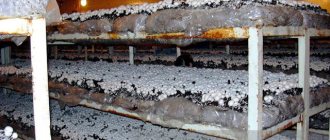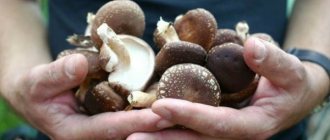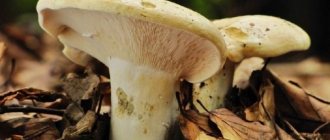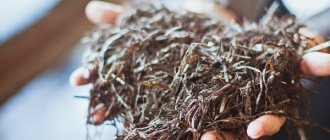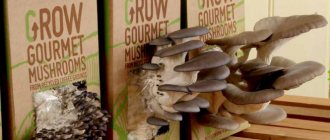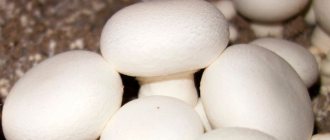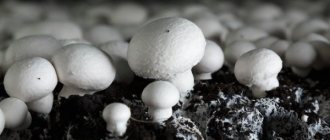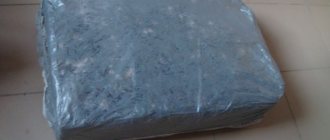Self-harvesting is an interesting and relatively simple activity that allows you to grow mushrooms year-round or throughout the season. Many of the latter usually grow in forests, but oyster mushrooms can be grown in sawdust in your basement. The nutritious and environmentally friendly product has healing properties. Compared to champignons, oyster mushrooms are less demanding in terms of care. And sawdust is considered the most natural and suitable environment for development. Thanks to demand and low costs, you can create a profitable business selling oyster mushrooms.
Oyster mushrooms: growing at home on stumps: technology, equipment
Cultivating oyster mushrooms on stumps is more suitable for homestead farming , since in this case:
- there is enough space to place logs
- It is possible to use cut trees
This method is simple and does not require special equipment. Let's consider the main stages of cultivation.
Prepare stumps of deciduous trees (except oak):
- wet the wood well with water
- make several holes 5 cm deep where the mycelium will be placed
Introduce planting material:
- pour mycelium into the holes
- cover with moss or bark
Oyster mushrooms on stumps
Another sowing option:
- Scatter mycelium grains onto the stump cut
- cover with a sawn circle
- secure with nails
Install stumps:
- dig shallow holes in the ground or sand in a dark place in the area
- install stumps in them
- cover with dry leaves or sawdust
- pour water
- cover with polyethylene
Take care of the mycelium:
- in dry weather, water the stump
- moisten the soil around the log
Sowing should be done in March - April. With proper care, you will get a harvest of mushrooms from stumps in 3-4 months.
Such a mycelium can bear fruit for several years, without taking a lot of your time and effort. You can also grow oyster mushrooms on stumps in the basement or cellar:
- planting technology is the same as in the previous version
- place the stumps in rooms where the necessary microclimate will be provided (basement, cellar)
Champignon care and harvesting
After planting the mycelium, the racks must be covered with film, and the temperature in the room must be monitored, which should be about 22-24 degrees. As soon as the mycelium begins to grow, the film is removed and the seedlings are periodically sprayed
Everyone knows that mushrooms grow best after rain, so champignons need to create suitable conditions.
After 10-12 days, the mushrooms are sprinkled with a layer of soil, and the temperature in the room is slightly reduced. During this period, it is also very important to ventilate the room more often.
Regularly spraying the champignons, 30-40 days after planting the mycelium, it will be possible to harvest. You need to pick mushrooms at a time when they have a whole film between the cap and the stem. In a later period, mushrooms already lose their usefulness and begin to accumulate harmful metals (if they are present in the substrate).
Mushrooms must be collected as carefully as possible, twisting them out of the ground. The mushroom hole must be sprinkled with soil.
Champignons are packed in polyethylene boxes, so they can be stored for up to several days. When frozen, mushrooms can not spoil for about 8 months.
Collect champignons very carefully, carefully twisting
Oyster mushrooms: growing at home in bags: technology, equipment
At home, oyster mushrooms are most often grown in bags. It is convenient to use these containers because they are compact and do not require much space to place them.
An intensive growing method is used, that is, bags in a room where a special microclimate is artificially maintained. You will need:
- plastic bags
- container for disinfecting the substrate (basin, tank, bucket)
- material for creating soil (husks, sawdust, straw)
- mycelium
- room where mushrooms will grow
Oyster mushrooms in bags
Process description:
- wash the bags
- treat them with a chlorine solution to disinfect
- fill the soil material with water
- stir and wash it
- drain dirty water
- pour water again and boil for about 3 hours (you can cook directly in bags)
- cool
- drain the water and squeeze the substrate well (you can put it under pressure)
- fill the bags with mycelium substrate, alternating them
- try to place mushroom seeds closer to the walls of the bag
- mycelium should be about 5% relative to the substrate
- tie the bag tightly
- cut the corners a little at the bottom so that excess moisture drains through the holes
- Every 12-15 cm, use a knife to make holes about 1-2 cm long
- place the bags in the selected room (do not stack them on top of each other, ensure free access of air to the side with holes. It is best to hang the bags)
- Maintain the room temperature at 20-24°C and humidity at 80-90%. No lighting will be required at this stage.
- do not allow moisture to get on the mushroom buds
- after the substrate in the bags is overgrown with mycelium and turns into a dense whitish mass, transfer them to another room with a temperature of 16-18°C and a humidity of 95%
- Maintain humidity by sprinkling bags with water from a sprinkler
- provide good ventilation in the room, or ventilate several times a day
- use dim lamps (at least 8 hours a day)
- Make the existing cuts in the bags a little larger so that the mushrooms grow out unhindered
Oyster mushrooms: growing at home in a greenhouse: technology, equipment
Having a greenhouse on your site, you can grow oyster mushrooms in it. The structure can be made of any material (glass, film). The main thing is to create the desired microclimate.
Greenhouse requirements:
- dim lighting - to do this, cover the walls with a special mesh or paint the greenhouse material with a chalk solution.
- possibility of changing temperature - each period of fungal development requires a certain temperature regime. The greenhouse should not heat above 25°C.
- ensuring high humidity - for this, purchase a sprinkler or install hoses.
- good ventilation - air flows should freely penetrate into the greenhouse when it is ventilated.
Hanger hangers from the greenhouse
You can grow oyster mushrooms in this building in different ways:
- extensive, when fruiting occurs after 3-4 months (stumps and logs are used)
- intensive, with the maintenance of a special microclimate, in which fruiting occurs in 1.5-2 months
Oyster mushrooms: growing at home in the basement: technology, equipment
In order to grow oyster mushrooms in the basement, it is necessary that it meet certain requirements:
- was sealed (to maintain the required temperature and humidity)
- there was no mold on the walls
- ceiling height must be at least 3 m
- the possibility of pest penetration is excluded
- had good ventilation
Before you start planting mushrooms, carefully prepare the basement:
- clear the space by removing unnecessary items
- if necessary, insulate the walls and floor (to maintain the temperature to 25°C)
- cover the basement walls with a special antifungal coating
- hang fluorescent lamps
- treat the room with a smoke bomb or other pest control products
- perform wet cleaning with chlorine solution
- divide the premises into two zones for different periods of mushroom growth
- buy a heater that can heat the room
Oyster mushrooms in the basement
After you have prepared the basement, you can start growing mushrooms in any way:
- on stumps and logs
- in containers with a suitable substrate
Throughout the entire growing process, it is necessary to provide a microclimate both during the incubation period and during the fruiting period. Due to the fact that the basement is usually empty and practically unused, growing oyster mushrooms in it is the most acceptable and convenient option, in which it is even possible to develop a small home business.
How to prepare the substrate and room for oyster mushrooms
Before the process of growing fruiting bodies, be sure to prepare the room and substrate.
Preparing the premises
You can grow mushrooms both in the basement and garage, and in your own apartment or private house. The main thing is that the room is prepared and has sufficient area - from twenty to thirty square meters. It also needs to be divided into two rooms - one for laying mycelium, and the second for germinating mushrooms.
Preparation process for cultivation:
- Throw out all unnecessary things from the room.
- Remove mold from the ceiling and walls, if any.
- Whiten them with lime.
- If the floor is made of concrete and brick, leave it as is, but if it is made of other materials, cover it with a thick layer of sand/crushed stone.
- Install ventilation, outlets and lighting, as mushrooms need light.
- Place wooden or metal racks for bags of substrate. The lower devices should be at a height of twenty centimeters.
- Disinfect bags, as well as working tools, using alcohol or hydrogen peroxide.
You may also be interested in the article: “Features of growing oyster mushrooms in the garage.”
Substrate preparation
Simply filling bags with habitat with planting material will not work - this is not a guarantee of successful cultivation of even mushrooms. Despite the fact that the latter rarely get sick, do not forget to protect them from mold and pathogenic microbes.
Sawdust processing process:
- Pour them into a large tank, fill with water, and then bring to a boil.
- Reduce heat and cook sawdust for two hours. After an hour, add a tablespoon of slaked lime.
- Drain the water, put the sawdust under pressure and cool to twenty-five degrees.
- Squeeze them until the moisture level is between 70 and 75 percent. If you don’t have a special device, don’t worry. Squeeze the sawdust in your fist - if your palm is wet, but without dripping water, then the humidity is suitable.
The temperature of the substrate for planting should be from twenty to twenty-five degrees. If the indicator is higher, the fungal spores will die.
Oyster mushrooms: growing at home in the garage: technology, equipment
The garage is one of the most suitable premises for growing oyster mushrooms, as it is usually heated and has a ventilation system. Thus, there is practically no need for its re-equipment.
Of course, it should not be used for its intended purpose. After thoroughly cleaning and disinfecting the premises, you only need to purchase some additional equipment:
- fluorescent lamps
- humidity sensors
- temperature meters
- fans
- heaters (if necessary)
- humidifiers, sprinklers
The technology for growing oyster mushrooms in a garage is identical to that used for basement cultivation:
- zonal division of the room
- substrate preparation
- seed mycelium laying
- maintaining the necessary climatic conditions
Oyster mushrooms: growing at home in sawdust: technology, equipment
Sawdust is good as a substrate because it has the ability to retain moisture within itself for a long time. However, the harvest from sawdust will be less than from a stump.
Oyster mushrooms in sawdust
Adhere to the basic technology requirements:
- For growing oyster mushrooms, choose sawdust from deciduous trees (beech, poplar, aspen, chestnut, hornbeam, birch). Conifers emit resins that have a negative effect on mushrooms.
- It is advisable to buy raw materials fresh
- if it is not possible to quickly use the purchased sawdust, store it in a dried form to avoid the appearance of mold
- grind the raw material to 4 mm
- boil for 2 hours (take 3 parts water for 1 part sawdust)
- after cooling to 25°C, you can add nutrients (for example, beer wort, oat bran)
- drain the water by placing the sawdust in the mesh
- sowing is carried out 14 hours after the water has drained
- use grain mycelium, as it survives better on this raw material
- It is preferable to use bags or wooden boxes as containers
- place in any suitable room (basement, greenhouse, garage)
Sawdust as an alternative to straw
Champignons grow on a specially prepared substrate. The yield largely depends on the quality of its preparation. The two main components of the substrate are manure and straw. They are used in a 1:1 ratio. You can use sawdust instead of straw. This is done extremely rarely, but in recent years this method has become increasingly popular.
If there is a woodworking shop next to the farm, then getting sawdust is much easier and cheaper than straw. But there is a very important point here: wood waste should only come from hardwood. Considering that a sawmill usually saws everything and does not separate the sawdust, it is more correct to purchase raw materials from coniferous trees.
Due to the presence of pine or spruce fragments in the sawdust, the yield will be greatly affected.
Instead of straw, you can use sawdust to make the substrate.
Oyster mushrooms: growing at home in straw: technology, equipment
Straw is the most preferred substrate for producing oyster mushrooms at home. Experts assure: the largest mushroom yield is obtained from this raw material.
Straw of various cereal crops is used for cultivation:
- wheat
- barley
- rye
- oats
Wheat straw is especially valuable in this regard. No special equipment is required for the process, only a means for chopping straw (knife, ax, industrial chopper).
The technology of using straw as a substrate consists of the following stages:
Preparation:
- choose porous straw with wide stems
- check for infection
- Before adding mycelium, grind the raw materials
- soak in water (the fresher the material, the longer the soaking)
Oyster mushrooms in straw
Hydrothermal treatment:
- put the straw in a larger container
- pour warm water
- bring the mixture to a temperature of 60-75°C (do not cook)
- leave it like that for three hours
- pour out the water
- cool to 25°C
- Place on a surface with a slope to ensure water drainage
Growing:
- place the straw in prepared bases (it is best to use a bag)
- alternate the substrate with seed mycelium
- grow in a suitable environment
Oyster mushrooms: growing at home on cardboard: technology, equipment
Unpretentious oyster mushroom can be grown even on paper. It’s hard to believe, but such a substrate is often used by amateur mushroom growers.
In general, there is nothing surprising in this: after all, paper is made from cellulose (wood material). For growing oyster mushrooms, it is preferable to use packaging cardboard:
- there is practically no printing ink on it
- it is accessible since packaging is often thrown away
- cardboard can be produced from several types of trees, which increases its nutritional value as a substrate
- porous structure ensures good breathability
Oyster mushrooms on cardboard
The technology is absolutely not complicated and consists of the following stages:
- rinse the cardboard under running water
- fill with hot water (60 degrees)
- leave for 7 hours, periodically adding hot water
- let cool to 25°C
- squeeze and straighten
- leave it unfolded for a while
- fold in a stack
- place between sheets add mycelium
- make holes
- put it in a bag and tie it
- keep in a dark place at 15-20°C
- After a couple of days, untie and drain excess water, if any.
- after 4 weeks, untie the bag and expose it to dim light
Of course, this method is absolutely not suitable for running a mushroom business.
In addition to studying technology and purchasing equipment, you also need to become familiar with other equally important aspects that will help you get a good harvest. You can read about temperature, ways to increase productivity and other useful information here. And for novice businessmen who are going to seriously engage in growing oyster mushrooms, this article will be useful.
What kind of mushrooms?
Mushrooms belong to the Veshenkov family. They are usually grown on the remains of plant materials by extracting cellulose and lignin from them. The fruiting body contains seventy percent proteins, which is why it is also called mushroom meat.
Oyster mushrooms contain fiber, which consists of chitin and helps normalize microflora, as well as the functioning of the gastrointestinal tract. The mushroom is useful if you are trying to boost your immunity and protect yourself from infections. Thanks to the sugar and sugar spirates in the composition, dishes prepared from these mushrooms have a special taste. And their ability to break down fats allows you to consume mushrooms even while losing weight.
